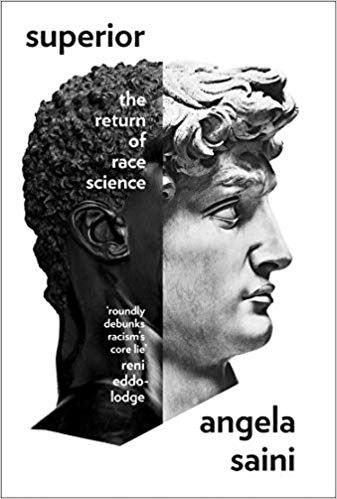
Race science has a dark history - but it is being resurrected in the 21st century. In her new book "Superior: The Return of Race Science" (Fourth Estate), award-winning author, and regular New Humanist contributor Angela Saini explores the concept of race, from its origins to the present day. Combining science, history and politics, it explains how race maps out biologically, the abuse of the idea of race, and how those on the far-right are attempting to repackage racism. Here, she discusses her arguments.
How old is the concept of “race” and how has it shifted over time?
It’s hard to say how people in the distant past thought about human difference. It’s implausible that they didn't notice difference at all, including things like skin colour, but certainly people didn’t always use racial categories the way we do now. A "race" used to refer to a family or a tribe. The distinct social categories we use today – for example, "black" and "Caucasian", are fairly recent, no more than a few hundred years old. And some are even more recent than that, for instance, "coloured" as is used in some countries, or "Latino". What’s important to remember is that race is a social construct, not a biological one, which is why categories vary across countries and why they have changed over time. Where we place the boundaries around groups of people is a social and political decision driven by power hierarchies, sometimes mediated by visual signals. We are a very homogeneous species, even more homogeneous than chimpanzees. The true source of human genetic difference is at the individual level, not the group level. What makes us believe that population-level differences are significant are culture and language – and these are of course not biological.
What are the origins of race science?
Our ideas about race are firmly rooted in modern Western science. During the Enlightenment, philosophers and natural scientists began to categorise humans in the same way that they classified the natural world. Often this was done without even much knowledge of what other people looked like or how they behaved, which is why botanist Carl Linnaeus included categories for ‘monster-like’ and ‘feral’ humans. White male upper-class Europeans throughout the 18th and 19th centuries placed themselves at the peak of their human hierarchies, and placed women, non-whites and lower classes below themselves. It was, looking back, quite obviously self-serving. But what’s remarkable is how these ideas stuck. They were used to justify colonialism, slavery, genocide and apartheid. They have underpinned some of the most virulently racist ideologies of the last 200 years, particularly white supremacy. And they have become so rooted in our societies that we continue to categorise ourselves in these ways. Our lives have been irrevocably shaped by them.
What happened to race science in the post-war era?
The horrific abuse of race science by the Nazis in Germany marked a turning point for race science. That isn’t to say that genocides didn’t occur before the Holocaust, and of course, they have occurred subsequently, too. But the Second World War served as a kind of wake-up call to the scientific community. Race science became taboo, and the study of race was finally moved to where it belonged in the social sciences as the study of racism. However, as I explore in Superior, many scientists continued to use the racial language and frameworks of the past in genetics and medicine. They still do. Also, on the fringes of science, scientific racists and eugenicists (including some Nazi race scientists who carried out experiments on Holocaust victims) well, they never gave up the ghost. They pressed on with their ideas, created their own journals and racist publications, and they are still at it even now. Indeed, one of the men in this original post-war network of scientific racists, as I found when I was writing the book, is still alive today.
You write that race science is undergoing a revival. What form is it taking?
Race science persists in two ways. One is in everyday science, when racial categories are used inappropriately by researchers who implicitly accept the assumption that they are genetically meaningful, even when the genetic evidence says they are not. We see this play out in health research in particularly. For instance, if you are under 55 and you have hypertension in the UK, the National Institute of Health and Care Excellence recommends a different drug if you are black. Epidemiologists I interviewed found that treatment on the basis of race in this case is about as useful as flipping a coin. Yet it still happens.
Equally worrying is the abuse of scientific data for racist purposes by those on the far-right. In this age of ethnic nationalism and disinformation, we have ended up with a toxic mix of 19th-century scientific racism being dredged up for political purposes online. We can hear tinges of eugenic thinking in modern politics, in the rhetoric of people like Steve Bannon, President Donald Trump’s former Chief Strategist. Bannon told French nationalists in 2018 that they should wear their racism as a “badge of honour”. Even Trump himself, when he complains about immigrants from what he describes as “shithole countries” implies that people from certain places are destined to be less desirable citizens. The Internet has in every way facilitated this rise in pseudoscientific thinking, and the blame for it can laid in part at the feet of the social media giants.
How much of this race science stands up to scrutiny?
There is no valid race science because race is not a valid scientific concept. We do know that there are genetic traits that run through families, including certain diseases, and that in particularly closed communities these traits can become statistically concentrated. But these cases are exceptions, not rules. We also know that there may be subtle statistical variations at the population level when it comes to certain features, such as skin colour or susceptibility to disease. But these do not run along the lines of our racial categories. There are no "black" or "white" genes. We are deeply heterogeneous within our socially-defined racial groups.
Can the modern field of population genetics be properly separated from race science?
Population genetics carries the racial baggage of the past, for no other reason than society itself carries it. The field is full of well-meaning, careful researchers, but many themselves will admit that they haven’t completely shed the language and frameworks of old-fashioned race science. They often group populations using social categories or national boundaries. Indeed, the big business of DNA ancestry testing emerged from the field of population genetics, and as much as geneticists decry ancestry testing as unscientific, there are scientists on the boards of many of these companies. Ancestry testing has reinforced the myth that race is real because the results as they are presented to people who undergo these tests use social categories to define them, without explaining how fuzzy they actually are, and how vague they have to be because of the lack of genetic distinction between the categories.
You express concern about the study of health differences between groups – such as higher instances of Type 2 diabetes among south Asians. What are your concerns? Is it ever justified to study these differences?
There are some small, statistical genetic differences between certain population groups when it comes to disease susceptibility, but these rarely run along racial lines. Health differences are far more often the product of diet, culture and other factors. Indeed, the surge in diabetes – a lifestyle disease – in India is largely because lifestyles have changed to become more sedentary and more full of fatty, sugary foods. Assuming that an individual is more likely to have a condition for racial reasons is risky because, firstly, it is fatalistic to assume that their diet or habits aren’t affecting them. Secondly, even if susceptibility rates are subtly higher at a population level, this tells you very little about any one individual patient. In the book, I include the case of a girl in the US whose cystic fibrosis wasn’t diagnosed until she was eight because she was black, and cystic fibrosis was assumed to be a "white" disease. Only when a passing radiologist saw a scan of her chest, when there was a colourblind assessment of her condition, was it finally identified. The lesson for health professionals is that every single person is different and needs to be treated as an individual.

